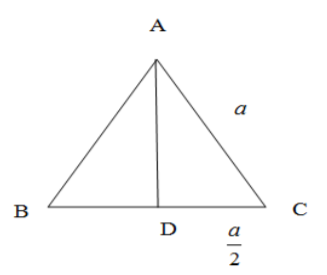
The area of an equilateral triangle is $16\sqrt{3}c{{m}^{2}}$ then finding the length of each side of that triangle.
Answer
574.8k+ views
Hint: Derive the formula of the area of an equilateral triangle from the formula of area of any triangle with length of side length $a$ and the perpendicular drawn from the opposite vertex $h$ $A=\dfrac{1}{2}\times a\times h$. Put the given area in the formula of the area of an equilateral triangle and obtain a quadratic equation. Solve the equation to find out the length of the side.
Complete step-by-step solution:
We know that the area of a triangle with any side of length $a$ and the perpendicular drawn from the vertex opposite to the side with length $h$ is given by the formula.
\[A=\dfrac{1}{2}\times a\times h\]

We have drawn in the given triangle ABC a perpendicular AD which meets BC at point D. We know that in an equilateral triangle all sides are of equal length. So $AB=BC=CA=a$. We also know that the perpendicular drawn from a vertex will bisect the opposite side. So $BD=CD=\dfrac{a}{2}$. \[\]
Now let us observe the triangle ADC which is a right angled triangle with hypotenuse $AC=a$ and side $CD=\dfrac{a}{2}$. Let $\text{AD}=\text{h}.$ We know from Pythagoras theorem the square of hypotenuse is sum of squares of other two side in a right angled triangle. Then we have,
\[ \begin{align}
& A{{C}^{2}}=C{{D}^{2}}+A{{D}^{2}} \\
& \Rightarrow {{a}^{2}}={{\left( \dfrac{a}{2} \right)}^{2}}+{{h}^{2}} \\
& \Rightarrow h=\sqrt{{{a}^{2}}-{{\dfrac{a}{4}}^{2}}}=\dfrac{\sqrt{3}}{2}a \\
\end{align} \]
So the area of an equilateral triangle is
\[A=\dfrac{1}{2}\times a\times \left( \dfrac{\sqrt{3}}{2}a \right)=\dfrac{\sqrt{3}}{4}{{a}^{2}}\]
It is given question that are of the equilateral triangle is $16\sqrt{3}c{{m}^{2}}=A$. Putting it in above equation we have,
\[\begin{align}
& 16\sqrt{3}=\dfrac{\sqrt{3}}{4}{{a}^{2}} \\
& \Rightarrow 16\times 4={{a}^{2}} \\
& \Rightarrow {{a}^{2}}=64 \\
\end{align}\]
We solve the above quadratic equation by linear factorisation and get ,
\[\begin{align}
& \Rightarrow {{a}^{2}}=64 \\
& \Rightarrow {{a}^{2}}-8\times 8=0 \\
& \Rightarrow \left( a+8 \right)\left( a-8 \right)=0 \\
\end{align}\]
So the possible values of $a$ is 8 and $-8$. As the length is always positive we reject the solution $a=-8$. So length of the side of the equilateral triangle is 8cm.
Note: It is important to distinguish between equilateral from isosceles triangles which have the same formula for the area as any triangle. It is also to noted that length and area are always positive and we need to reject negative values arising in quadratic equations.
Complete step-by-step solution:
We know that the area of a triangle with any side of length $a$ and the perpendicular drawn from the vertex opposite to the side with length $h$ is given by the formula.
\[A=\dfrac{1}{2}\times a\times h\]

We have drawn in the given triangle ABC a perpendicular AD which meets BC at point D. We know that in an equilateral triangle all sides are of equal length. So $AB=BC=CA=a$. We also know that the perpendicular drawn from a vertex will bisect the opposite side. So $BD=CD=\dfrac{a}{2}$. \[\]
Now let us observe the triangle ADC which is a right angled triangle with hypotenuse $AC=a$ and side $CD=\dfrac{a}{2}$. Let $\text{AD}=\text{h}.$ We know from Pythagoras theorem the square of hypotenuse is sum of squares of other two side in a right angled triangle. Then we have,
\[ \begin{align}
& A{{C}^{2}}=C{{D}^{2}}+A{{D}^{2}} \\
& \Rightarrow {{a}^{2}}={{\left( \dfrac{a}{2} \right)}^{2}}+{{h}^{2}} \\
& \Rightarrow h=\sqrt{{{a}^{2}}-{{\dfrac{a}{4}}^{2}}}=\dfrac{\sqrt{3}}{2}a \\
\end{align} \]
So the area of an equilateral triangle is
\[A=\dfrac{1}{2}\times a\times \left( \dfrac{\sqrt{3}}{2}a \right)=\dfrac{\sqrt{3}}{4}{{a}^{2}}\]
It is given question that are of the equilateral triangle is $16\sqrt{3}c{{m}^{2}}=A$. Putting it in above equation we have,
\[\begin{align}
& 16\sqrt{3}=\dfrac{\sqrt{3}}{4}{{a}^{2}} \\
& \Rightarrow 16\times 4={{a}^{2}} \\
& \Rightarrow {{a}^{2}}=64 \\
\end{align}\]
We solve the above quadratic equation by linear factorisation and get ,
\[\begin{align}
& \Rightarrow {{a}^{2}}=64 \\
& \Rightarrow {{a}^{2}}-8\times 8=0 \\
& \Rightarrow \left( a+8 \right)\left( a-8 \right)=0 \\
\end{align}\]
So the possible values of $a$ is 8 and $-8$. As the length is always positive we reject the solution $a=-8$. So length of the side of the equilateral triangle is 8cm.
Note: It is important to distinguish between equilateral from isosceles triangles which have the same formula for the area as any triangle. It is also to noted that length and area are always positive and we need to reject negative values arising in quadratic equations.
Recently Updated Pages
Two men on either side of the cliff 90m height observe class 10 maths CBSE

What happens to glucose which enters nephron along class 10 biology CBSE

Cutting of the Chinese melon means A The business and class 10 social science CBSE

Write a dialogue with at least ten utterances between class 10 english CBSE

Show an aquatic food chain using the following organisms class 10 biology CBSE

A circle is inscribed in an equilateral triangle and class 10 maths CBSE

Trending doubts
Why is there a time difference of about 5 hours between class 10 social science CBSE

Write a letter to the principal requesting him to grant class 10 english CBSE

What is the median of the first 10 natural numbers class 10 maths CBSE

The Equation xxx + 2 is Satisfied when x is Equal to Class 10 Maths

Which of the following does not have a fundamental class 10 physics CBSE

State and prove converse of BPT Basic Proportionality class 10 maths CBSE




